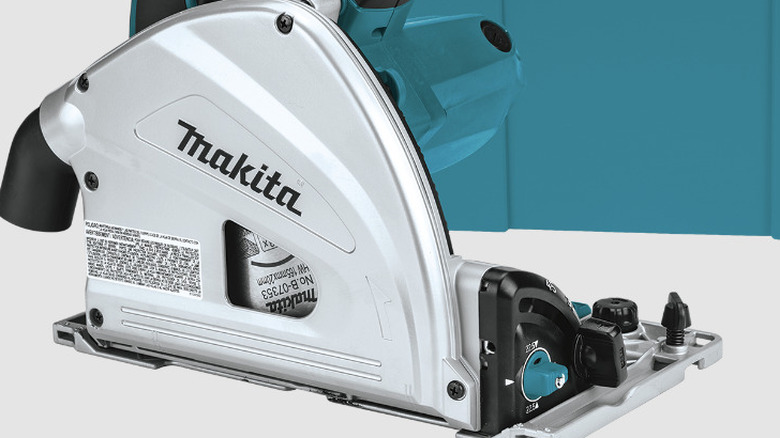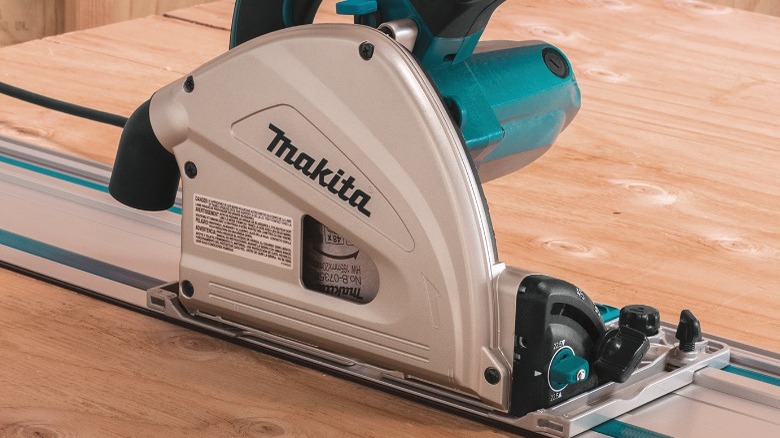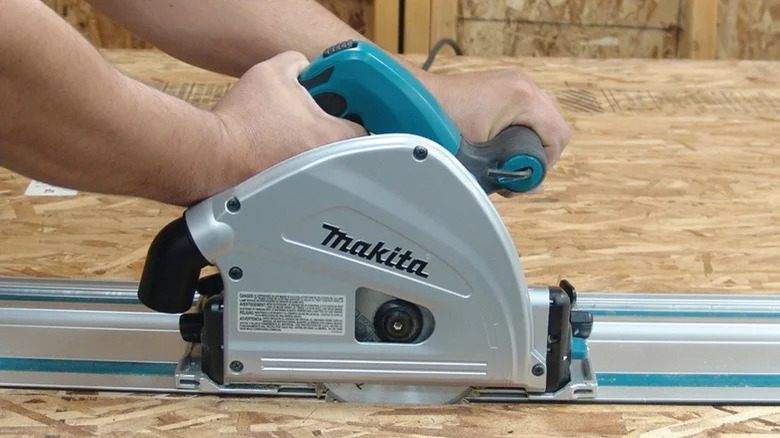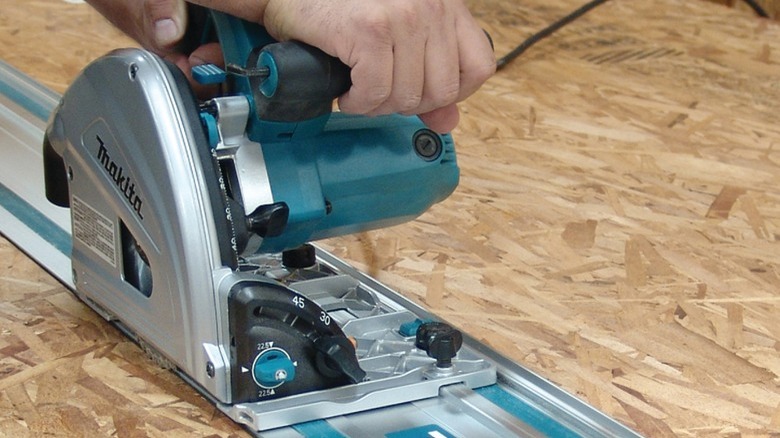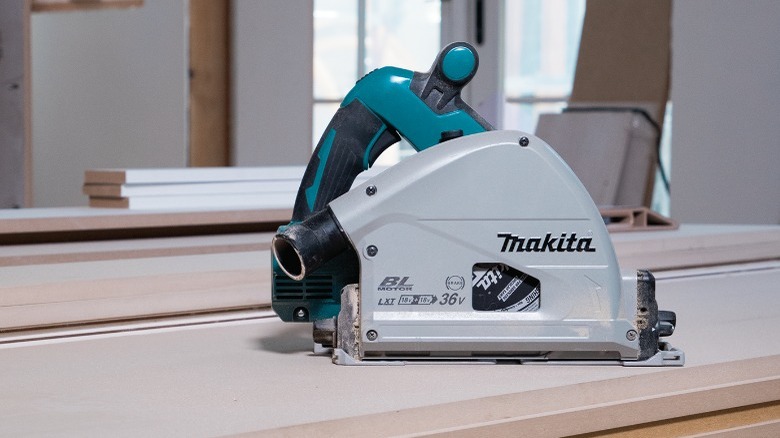About Makita's Track Saws: Pros, Cons, And What To Know Before You Buy
A good track saw is a handy tool if you find yourself needing to break down large sheets of plywood, live-edge wooden slabs, or other rigid materials that are too big to fit on a table saw. You can always try to free-hand the cut with a regular circular saw, but even the steadiest carpenter will have a hard time keeping the saw perfectly straight down an 8-foot line. Track saws, AKA plunge saws, are a special type of circular saw. They're better at performing plunge cuts in the center of a board if you need to cut out a rectangular shape and are designed to work in tandem with straight metal tracks that can be clamped or bolted to the material you're cutting to ensure that you get a perfectly straight cut every time. So if you're working on the kinds of DIY carpentry projects where you need to get a perfectly square, table saw quality cut on a large sheet, then a track saw is going to be your new best friend.
Makita is widely considered to be one of the best power tool brands on the market. The company has a wide variety of products in its catalog, including a few track saws. These can be quite the investment, however, so you'll want to be sure that whichever one you choose will suit all of your needs. To that end, it's worth taking a look at the pros, what are the cons, and whether are they compatible with track saws from other brands.
Pro: Makita's track saws are powerful
One of the most important factors in choosing any power tool is making sure that its performance metrics live up to your needs. Not all of Makita's track saws are the most powerful models on the market, but even the weakest among them is a major step up from most budget brands. These tools offer more than enough juice to make sure that you can get smooth cuts through any plywood or other sheet materials you're likely to encounter without needing to worry about stalling, kickback, or chip out so long as you're working with a clean, sharp blade.
There are several kits out there pairing these saws with different-sized tracks and other accessories, but there appear to be only three models of the tool itself. There's the corded 12 Amp 6 ½-inch Plunge Cut Saw, which has operational speeds between 2,000-5,200 RPM, the 18V X2 LXT (36V) Brushless Cordless 6 ½-inch Plunge Circular Saw with speeds between 2,500-6,300 RPM, and the 40V Max XGT Brushless Cordless 6 ½-inch Plunge Circular Saw with speeds between 2,500-4,900 RPM.
Only the fastest of these models manages to match the 6,300 RPM you can get on the Milwaukee track saw, but even the slowest among them easily outclasses Ryobi's 4,300 RPM cordless saw.
Con: Track saws are costly
Of course, another major factor that comes into play whenever you want to buy a tool is the price. While Makita's tools do have a reputation for solid performance and cutting-edge technology, they tend to be on the more expensive side. It seems that the company's track saws are no different. The 18V X2 MSRPs at $429, while the 12 Amp corded saw and the 40V Max cordless both go for $459–and that's just for the tool alone. You'll need a high-capacity Makita battery and charger for the cordless options if you don't already have one, and those who wish to use the plunge saw as a track saw will need to buy an actual track.
Makita sells a few kits that have varying assortments of batteries, chargers, and accessories that you need to get started. You can get the corded 12 Amp saw and track together for $557 (the same price as the cordless Milwaukee kit) or you can get a similar kit for the cordless Makita 18V X2 for $727. You can also buy 55-inch tracks separately for $98. Then there are the really big kits that include multiple guide rails, batteries, chargers, carrying cases, clamps, and other supplies. These come at several price points, ranging up to just under $1,000. This is more affordable than some high-end brands like Festool, but that doesn't mean it's cheap.
Pro: Makita's track saws are highly rated
The good news is that even though these track saws cost a pretty penny, you can be fairly certain that you're getting a quality product. All three of the different Makita track saws have perfect, five-star ratings on the Home Depot website. There are very few complaints in any of the customers' reviews that remark on the quality of the actual product. Most just had complaints about the shipping or the price. Customers aren't alone in this assessment, either. Professional reviewers have had a lot of good things to say about these saws as well.
Daily Woodworks did a one-year review of the 18V X2 where he talked about his experience with the saw and compared it to the high-end Festool TSC setup. "The cut quality on both saws is phenomenal. My cuts are buttery-smooth without tear out. It's powerful, it's easy to use, it's accurate, and it's quality." he said. "So if you're looking for a Track Saw set up I can 100% recommend the Makita."
Richard Kent of Pro Tool Reviews gave the corded model a weighted 9.2 out of 10 in his review. "The only flaw I could find was the lack of a riving knife, which can lead to kickback if you're not cautious. Otherwise, it's a solid performer in the field or shop."
Con: Makita doesn't have the best warranties
When you're spending a lot of money on a tool, you want to make sure it is going to last a long time. Warranties can bring peace of mind in these situations. They allow you to put your tools through their paces with the knowledge that you can easily get them repaired or replaced if they wear out or break.
Unfortunately, Makita's warranty policy isn't as generous as some of its competitors. Most tools only get one year of coverage, along with Makita's promised 30-day satisfaction guarantee. This applies to the corded 12 Amp track saw. Fortunately, the policy is a bit better for the company's battery-powered tools. "Every Makita Lithium-Ion Tool, Battery, Charger, and Pneumatic Nailer is warranted to be free of defects from workmanship and materials for the period of THREE YEARS from the date of original purchase," the warranty states. This means that you will get more coverage if you opt for the cordless 18V X2 or the 40V Max version. It's worth noting that both warranties only cover damage due to factory defects, however. They don't cover breakage due to wear and tear, environmental damage, or modification.
